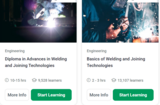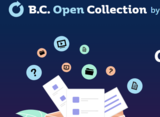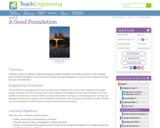
Free courses available to learn welding skills. Courses range 2-30 hours.
- Subject:
- Practical & Applied Arts
- Material Type:
- Activity/Lab
- Unit of Study
- Author:
- Alison Empower Yourself
- Date Added:
- 11/09/2023

Free courses available to learn welding skills. Courses range 2-30 hours.

Find materials free course materials for educators. The materials are all free, open and can be customized to suit your needs.
Education
Academic/Career Success
Art & Design
Biological/Physical Sciences
Business
Communication & Writing
Computer Science
Earth/Ocean Science
Engineering
Health and Medical
Hospitality Tourism
Humanities
Language Learning
Law and Criminal Justice
Math and Statistics
Social Sciences
Trades
Digital Literacy

Students use LEGO® MINDSTORMS® robotics to help conceptualize and understand the force of friction. Specifically, they observe how different surfaces in contact result in different frictional forces. A LEGO robot is constructed to pull a two-wheeled trailer made of LEGO parts. The robot is programmed to pull the trailer 10 feet and trial runs are conducted on smooth and textured surfaces. The speed and motor power of the robot is kept constant in all trials so students observe the effect of friction between various combinations of surfaces and trailer wheels. To apply what they learn, students act as engineers and create the most effective car by designing the most optimal tires for given surface conditions.

The lesson will first explore the concept of current in electrical circuits. Current will be defined as the flow of electrons. Photovoltaic (PV) cell properties will then be introduced. Generally constructed of silicon, photovoltaic cells contain a large number of electrons BUT they can be thought of as "frozen" in their natural state. A source of energy is required to "free" these electrons if we wish to create current. Light from the sun provides this energy. This will lead to the principle of "Conservation of Energy." Finally, with a basic understanding of the circuits through Ohm's law, students will see how the energy from the sun can be used to power everyday items, including vehicles. This lesson utilizes the engineering design activity of building a solar car to help students learn these concepts.

Students are introduced to the multidisciplinary field of material science. Through a class demo and PowerPoint® presentation, they learn the basic classes of materials (metals, ceramics, polymers, composites) and how they differ from one another, considering concepts such as stress, strain, ductile, brittle, deformation and fracture. Practical examples help students understand how the materials are applied, and further information about specific research illustrates how materials and material science are useful in space exploration. A worksheet and quiz are provided.

This week we are exploring alternative energy sources. We'll look at how biomass can be burned as a fuel source, how hydrogen can be used in a fuel cell to generate electrical power, and how nuclear fission provides power to the grid. We'll also discuss how nuclear fusion might someday do the same without any radioactive waste.

In this brief video, NASA scientists discuss the Global Precipitation Measurement (GPM) mission and its role in studying and tracking Earth's freshwater resources. The GPM mission will advance our understanding of Earth's water and energy cycles, improve the forecasting of extreme events that cause natural disasters, and extend current capabilities of using satellite precipitation information to directly benefit society.

During a scavenger hunt and an art project, students learn how to use a handheld GPS receiver for personal navigation. Teachers can request assistance from the Institute of Navigation to find nearby members with experience in using GPS and in locating receivers to use.

Pump gas molecules to a box and see what happens as you change the volume, add or remove heat, change gravity, and more. Measure the temperature and pressure, and discover how the properties of the gas vary in relation to each other.

This is a set of four, one-page problems about the distance craft travel on Mars. Learners will use the Pythagorean Theorem to determine distance between a series of hypothetical exploration sites within Gale Crater on Mars. Options are presented so that students may learn about the Mars Science Laboratory (MSL) mission through a NASA press release or by viewing a NASA eClips video [6 min.]. This activity is part of the Space Math multi-media modules that integrate NASA press releases, NASA archival video, and mathematics problems targeted at specific math standards commonly encountered in middle school.

In this lesson, students will investigate error. As shown in earlier activities from navigation lessons 1 through 3, without an understanding of how errors can affect your position, you cannot navigate well. Introducing accuracy and precision will develop these concepts further. Also, students will learn how computers can help in navigation. Often, the calculations needed to navigate accurately are time consuming and complex. By using the power of computers to do calculations and repetitive tasks, one can quickly see how changing parameters likes angles and distances and introducing errors will affect their overall result.

In this lesson, students learn how to determine location by triangulation. We describe the process of triangulation and practice finding your location on a worksheet, in the classroom, and outdoors.

In this fun engineering activity, you are challenged to build a gingerbread house that meets specific design requirements.
Holiday fun!

This resources identifies best practices for giving presentations or talks in elementary classrooms and was developed to help scientists and engineers who have been asked to visit an elementary classroom. It provides helpful suggestions before, during, and after the presentation, as well questions for the teacher (e.g., what content do you want me to cover, what have students already learned about this content?).

This resources identifies best practices for giving presentations or talks in middle school classrooms and was developed to help scientists and engineers who have been asked to visit a middle school classroom. It provides helpful suggestions before, during, and after the presentation, as well questions for the teacher (e.g., what content do you want me to cover, what have students already learned about this content?).

This manual provides simple demonstrations to show how lenses and mirrors are used to create telescopes. It was created for use by the Night Sky Network of astronomy clubs.

Students use hot glue gun sticks to learn about the forces of tension, compression and torsion.

Students will answer the Challenge Question and use the acquired learning from Lesson 1, "Fix the Hip Challenge" and Lesson 2, "Skeletal System Overview"to construct an informative brochure addressing osteoporosis and the role biomedical engineering plays in diagnosing and preventing this disease.

This is a lesson about planetary atmospheres. Learners will interpret real spectral graphs from missions to determine what some of Earth, Venus, and Mars‰Ûª atmosphere is composed of and then mathematically compare the amount of the greenhouse gas, CO2, on the planets Venus, Earth, and Mars in order to determine which has the most. Students brainstorm to figure out what things, along with greenhouse gases, can affect a planet‰Ûªs temperature. The activity is part of Project Spectra, a science and engineering program for middle-high school students, focusing on how light is used to explore the Solar System.

Students explore the effects of regional geology on bridge foundation, including the variety of soil conditions found beneath foundations. They learn about shallow and deep foundations, as well as the concepts of bearing pressure and settlement.